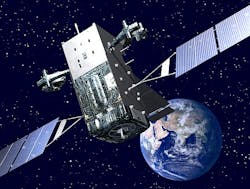Air Force reaches out to industry for companies able to build advanced IR sensor processing
LOS ANGELES AFB, Calif., 29 Jan. 2014. U.S. Air Force missile-defense experts are looking for defense companies with the expertise to develop ground-based advanced data processing for satellite infrared detectors designed to alert authorities to missile launches on Earth.
Officials of the Air Force Space and Missile Systems Center at Los Angeles Air Force Base, Calif., on Monday issued a request for information (14-030) for the Overhead Persistent Infrared (OPIR) R&D-Mission Data Processor (MDP) Ground System program.
The RFI is seeking information on industry's ability to develop an OPIR mission data processor (MDP) ground system to support the 6-degree wide field-of-view testbed (6-degree WTB), which will help evaluate sensors and signal-processing technology for using orbiting infrared sensors, such as the Space-Based Infrared System (SBIRS), to the plumes of missile launches on the Earth's surface.
Related: Air Force STAMPEDE program to develop high-temp MWIR sensor chips for satellites
Issuing the RFI are officials of the Space Based Infrared Program Office (IS) of the Air Force Space and Missile Systems Center. Air Force officials expect to launch the 6-degree WTB in the fall of 2016. To do this, they need to field the OPIR mission data processor by summer 2016 to support the pre-launch readiness review, launch, and post-launch activities.
The kind of mission data processor that Air Force experts want to support the 6-degree wide field-of-view testbed will have several specific capabilities.
First, the sensor-processing system should have initial wide field-of-view (WFOV) staring sensor simulation capability, including sensor optics, background clutter, and jitter modeling to generate regression test data sets provided by the government.
Related: Northrop Grumman and Lockheed Martin complete SBIRS HEO-3 payload integration test
Next, the processor designer should be able to develop WFOV testbed ingest routines, and signal processing algorithms for calibration, clutter suppression, thresholding, closely spaced object determination, and line-of-sight. Algorithms should be compatible with a government provided application program interface (API) in a government-provided plug-and-play modular architecture.
The mission data processor designer should be able to upgrade government processors with new functionality over time. Air Force experts expect the project will involve real-time processing capability of at least 100 megabits per second of uncompressed data.
The processor should be able to track, fuse, and estimate data involving missile launch points, headings, and other relevant information for WFOV testbed and other OPIR assets, with limited source code provided by the government.
Related: Lockheed Martin receives core for fourth SBIRS GEO satellite
The processor should be able to provide 2D imagery in real time from data flowing in at speeds of at least 200 megabits per second for tracking, fusion, and tactical parameter estimation, and with periodic overlays of weather, digital terrain information, coast lines, and other relevant data.
The mission data processor also should be able to visualize fused data in real time processed from the WFOV testbed and other OPIR assets in 3D, with periodic overlays of weather and digital terrain information.
Companies interested should email statements of capabilities to the Air Force's Christopher Lee at [email protected], or Capt. Mark Wojtowicz at [email protected], no later than 17 Feb. 2014.
Related: Lockheed Martin delivers new flight software architecture for SBIRS GEO spacecraft
For routine questions or concerns email Lee or Wojtowicz at the email addresses above, or phone Lee at 310-653-4764 or Wojtowicz at 310-653-4421. For significant concerns phone Ombudsman James Gill at 310-653-1789.
More information is online at https://www.fbo.gov/spg/USAF/AFSC/SMCSMSC/14-030/listing.html.

